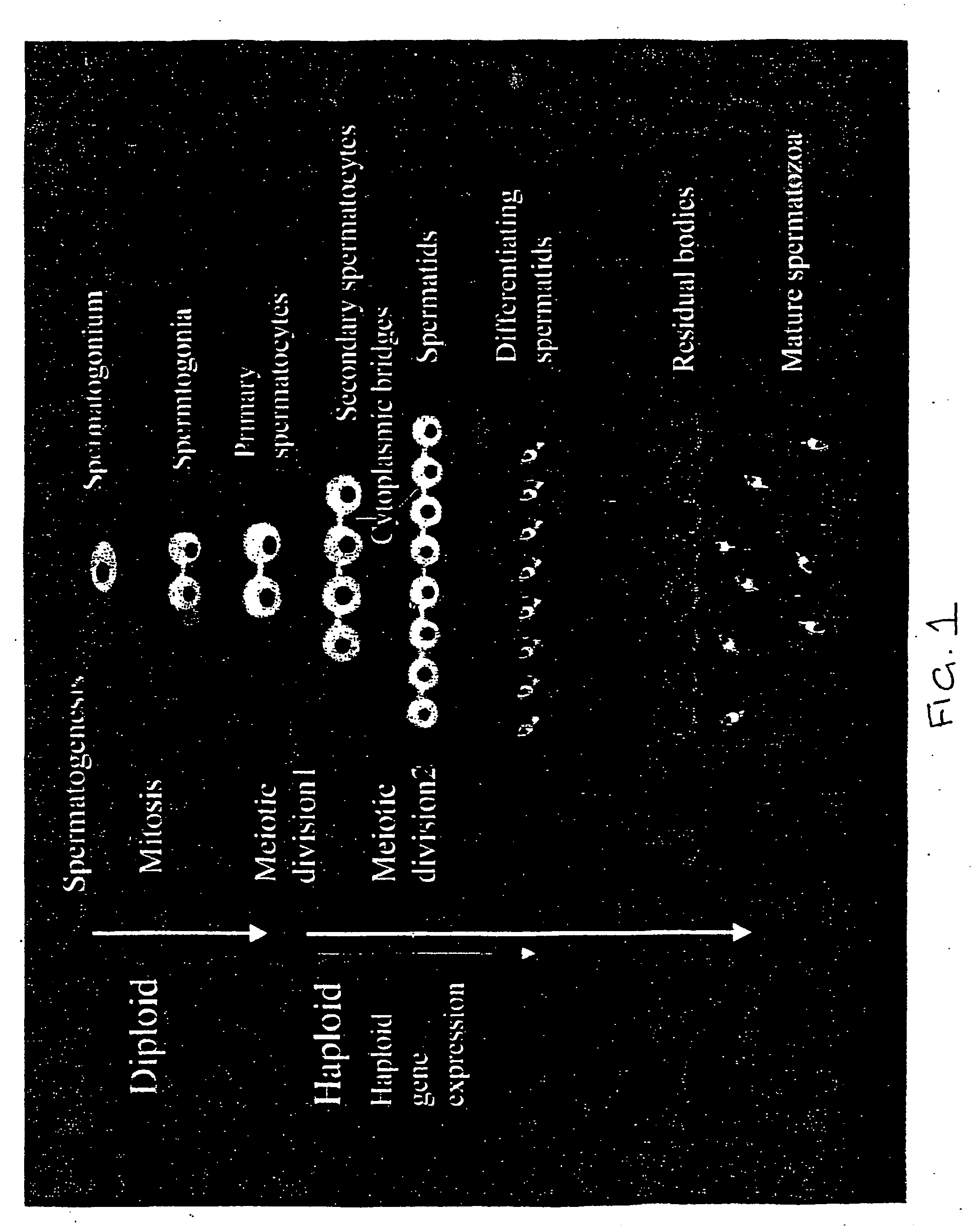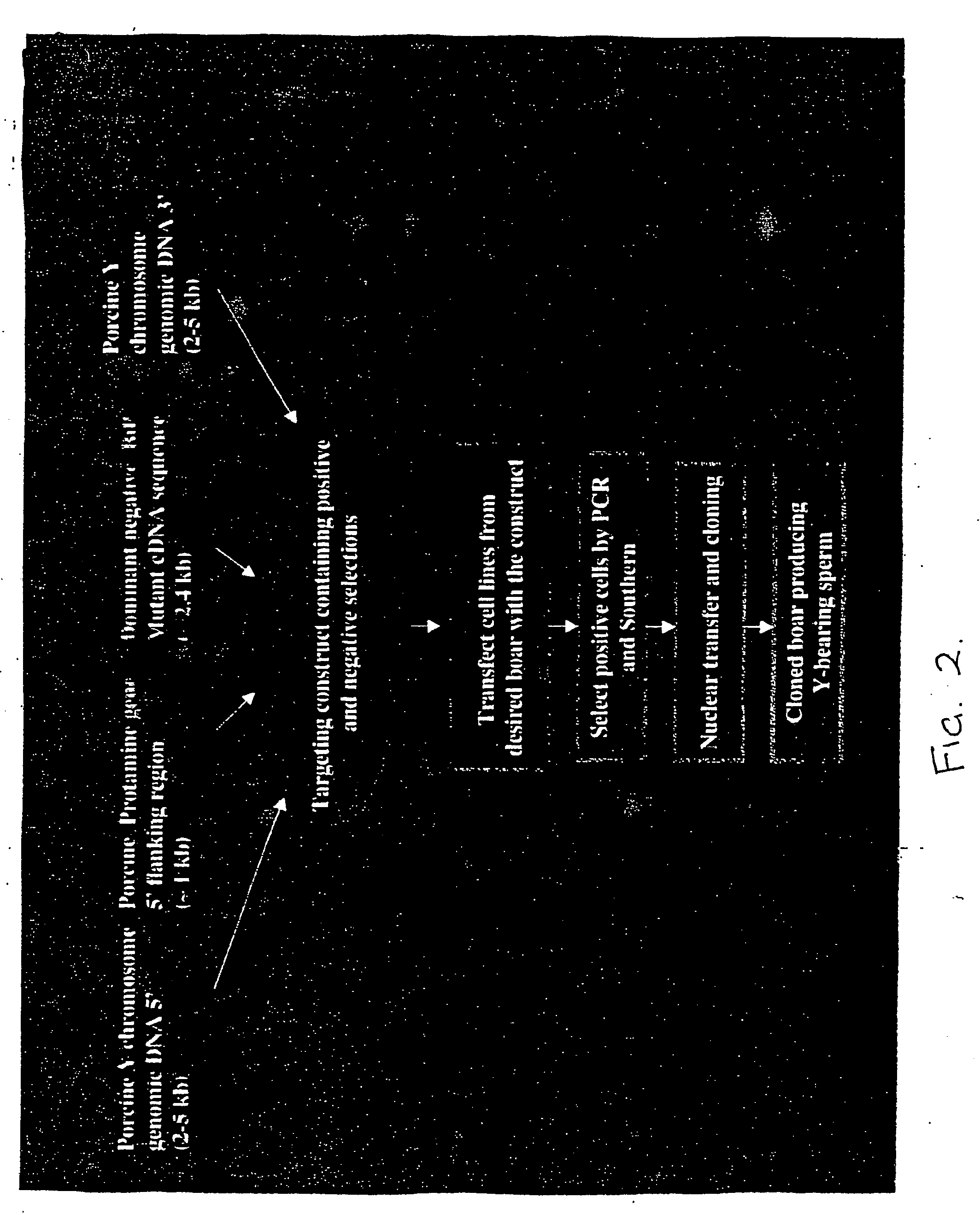Sex- specific selection of sperm from transgenic animals
a transgenic animal and sperm technology, applied in the field of sex-specific selection of sperm from transgenic animals, can solve the problems of limited technique, expensive machines, and inability to meet the needs of patients, and achieve the effects of increasing the reproductive capacity of genetically prized animals, reducing the cost of treatment, and increasing the speed of treatmen
- Summary
- Abstract
- Description
- Claims
- Application Information
AI Technical Summary
Benefits of technology
Problems solved by technology
Method used
Image
Examples
example 1
Targeting Vectors
[0135] Preferred targeting vectors include four major elements. A promoter, preferably the protamine gene promoter, is linked to, and drives, the expression of a gene, preferably the hamster BiP protein, to disrupt sperm development. Both wild-type and mutant hamster BiP genes may be used to prepare vectors. The third element of the vectors is a Y or X chromosome specific DNA sequence which is linked to the promoter / gene elements. The Y or X chromosome specific sequence is to be used as homologous arms for targeting the vector to the Y or X chromosome, respectively. The fourth element of the vectors is a selection marker, such as the neomycin-resistance gene, neo (Southern, P. J. & Berg, P. (1982) J Mol Appl Genet 1: 327-341).
[0136] Preferred elements of the vectors which may be obtained and incorporated into the targeting vectors include novel sequence of both the bovine (Lee et al (1987) Biol Chem Hoppe Seyler 368: 131-135; Krawetz et al., (1988) J Biol Chem 263...
example 2
Cloning Transgenic Porcine Animals
[0163] Porcine Oocyte Recovery and Maturation
[0164] Sow and gilt ovaries were collected at separate, local abattoirs and maintained at 30° C. during transport to the laboratory. Follicles ranging from 2-8 mm were aspirated into 50 ml conical centrifuge tubes (BD Biosciences, Franklin Lakes, N.J.) using 18 gauge needles and vacuum set at 100 mm of mercury. Follicular fluid and aspirated oocytes from sows and gilts were pooled separately and rinsed through EmCon® filters (Iowa Veterinary Supply Company, Iowa Falls, Iowa) with HEPES buffered Tyrodes solution (13iowhittaker, Walkersville, Md.). Oocytes surrounded by a compact cumulus mass were selected and placed into North Carolina State University (NCSU) 37 oocyte maturation medium (Petters et al., J Reprod Fertil Suppl 48, 61-73 (1993)) supplemented with 0.1 mg / ml cysteine (Grupen et al., Biol Reprod 53, 173-178 (1995)), 10 ng / ml EGF (epidermal growth factor) (Grupen et al., Reprod Fertil Dev 9, 57...
example 3
Cloning Transgenic Bovine Animals
[0171] Embryo Construction
[0172] Oocytes aspirated from ovaries were matured overnight (about 16-18 hours) in maturation medium. Medium 199 (Biowhittaker, Cat #12-119F) supplemented with luteinizing hormone 10IU / ml (LH; Sigma, Cat #L9773), 1 mg / ml estradiol (Sigma, Cat #E8875) and 10% FCS or estrus cow serum, was used.
[0173] Oocytes were stripped of their cumulus cell layers and nuclear material stained with Hoechst 33342 5mg / ml (Sigma, Cat #2261) in TL HEPES solution supplemented with cytochalasin B (7 μg / ml, Sigma, Cat #C6762) for 15 min. Oocytes were then enucleated in TL HEPES solution under mineral oil. A single nuclear donor cell of optimal size (12 to 15 μm) was then inserted from a cell suspension and injected into the perivitelline space of the enucleated oocyte. The cell and oocyte membranes were then induced to fuse by electrofusion in a 500 μm chamber by application of an electrical pulse of 90V for 15 μs, forming a cybrid.
[0174] 3-4 ...
PUM
 Login to View More
Login to View More Abstract
Description
Claims
Application Information
 Login to View More
Login to View More - R&D
- Intellectual Property
- Life Sciences
- Materials
- Tech Scout
- Unparalleled Data Quality
- Higher Quality Content
- 60% Fewer Hallucinations
Browse by: Latest US Patents, China's latest patents, Technical Efficacy Thesaurus, Application Domain, Technology Topic, Popular Technical Reports.
© 2025 PatSnap. All rights reserved.Legal|Privacy policy|Modern Slavery Act Transparency Statement|Sitemap|About US| Contact US: help@patsnap.com



